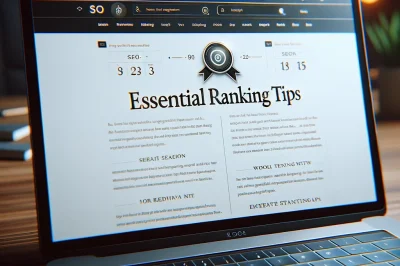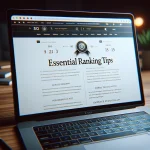Table of Contents

Key Takeaways
- Ensure your WordPress site is visible to search engines in the settings.
- Use SEO-friendly URL structures to make your content more accessible to Google.
- Choose a reliable hosting service to improve site speed and uptime.
- Select and configure the right SEO plugin for your WordPress site.
- Conduct thorough keyword research to target the right audience.
Setting Up for Success: WordPress SEO Fundamentals
Before we jump into the deep end, let’s get the basics right. SEO, or Search Engine Optimization, is all about making your site friendly to search engines like Google. This means tweaking your site so that when people search for topics you write about, your blog comes up as a top result.
Choosing the Right Hosting Service for Speed and Uptime
First things first, your blog needs a solid foundation. That’s where a good hosting service comes in. It’s like the home for your blog on the internet. A fast and reliable host is crucial because it affects how quickly your site loads and how often it’s available. Slow loading times or frequent downtimes can make visitors bounce off your site and Google won’t like that.
Most importantly, here’s what to look for in a hosting service:
- Uptime guarantees: Aim for 99.9% uptime. This means your site is almost always available.
- Speed: Look for hosts with fast servers and caching options to speed up your site.
- Support: Good customer support can save you a lot of headaches down the line.
- Security: Features like SSL certificates help protect your site and boost SEO.
Setting Your WordPress Visibility for Search Engines
Now, let’s ensure that search engines can actually find your blog. There’s a little checkbox in WordPress that can make or break your visibility. You’ll find it under Settings > Reading. Make sure the ‘Discourage search engines from indexing this site’ option is unchecked. This tells search engines, “Hey, come check out my content!”
Crafting SEO-Friendly URLs and Permalink Structures
Next up, let’s talk about URLs. They’re like the address for each piece of content you create. You want them to be clear and descriptive, not just for your readers but also for search engines. Go to Settings > Permalinks and choose a structure that includes the post name. This makes your URLs readable and rich with keywords, which is great for SEO.
Here’s an example:
Before: yourblog.com/?p=123
After: yourblog.com/5-tips-for-better-seo
See how the second one gives you an idea of what the page is about? That’s what you’re aiming for.
Leveraging Plugins and Tools for Maximum Impact
WordPress is amazing because it gives you a ton of plugins to boost your SEO. But with so many options, it’s easy to get overwhelmed. Let’s focus on the essentials.
Selecting a Dynamic SEO Plugin
Think of SEO plugins as your blog’s personal trainer. They push you to optimize every post and page for search engines. There are quite a few out there, but you want one that’s comprehensive and user-friendly. Yoast SEO, All-in-One SEO, and Rank Math are some of the top contenders. Install one and it will guide you through optimizing your content step by step.
Here’s what a good SEO plugin should offer:
- Title and meta description templating for better branding and consistent snippets in search results.
- Sitemap creation to help search engines crawl your site more effectively.
- Content analysis to ensure you’re using keywords properly and creating readable text.
- Social media integration for those important social signals.
Remember, the goal here is to make your blog as attractive as possible to both readers and search engines.
Mastering the Art of the SEO Plugin: From Setup to Advanced Features
Once you’ve chosen your SEO plugin, it’s time to get to know it well. Start with the basics: set your site’s title and meta description. These show up in search results and can entice people to click through to your site. Then, dive into the more advanced features. Use the plugin to create XML sitemaps, connect to Google Search Console, and optimize individual posts and pages.
Here’s a simple checklist to get you started with local link building strategies for your business.
- Set your site’s title and tagline to reflect your blog’s theme.
- Generate an XML sitemap and submit it to search engines.
- Use the content analysis tool to improve posts before you hit publish.
- Configure social media settings to enhance sharing and visibility.
By getting these settings right, you’re laying a strong foundation for your site’s SEO.
Stay tuned, as we’ll dive deeper into keyword research and content strategies in the next sections. These are the real game changers that will help your blog shine in the crowded online space.
Infusing Your Content with the Right Keywords
Keyword research is like a treasure hunt. It’s all about finding the words and phrases that your audience is searching for. This is crucial because these are the terms you’ll want to include in your content to show up in search results. But it’s not just about stuffing your posts with keywords. It’s about understanding what your readers are looking for and providing the best answer. For those new to this process, consider following a detailed WordPress SEO guide to optimize your content effectively.
Start by brainstorming topics related to your blog’s niche. Then, use tools like Google’s Keyword Planner or even just the search suggestions when you start typing in Google. These can give you insights into the most searched terms. Remember, the goal is to find keywords that are relevant, have a decent amount of searches, but aren’t so competitive that you can’t rank for them.
Once you’ve got your keywords, sprinkle them throughout your content naturally. Include them in your post titles, headings, and the body of your content. But always prioritize readability. If it doesn’t sound natural, it’s not worth it. Search engines are smart and can tell when you’re overdoing it.
On-Page SEO: Tweaking Your Content for Search Engines
On-page SEO is about making sure each page on your blog is optimized for both search engines and readers. It’s not just about keywords; it’s about the overall quality and structure of your content. Think of it as fine-tuning your blog posts so they can perform their best in search engine results pages (SERPs).
Some key aspects of on-page SEO include using headings to structure your content, optimizing images with alt text, and making sure your site is mobile-friendly. All these elements help search engines understand your content better and can lead to higher rankings.
Titling for Impact: SEO-Boosting Post Titles
Your post title is the first thing people see in search results, so it needs to make an impact. It should be clear, catchy, and include your main keyword. But there’s a balance – your title should also reflect what the post is truly about. Misleading titles can lead to high bounce rates, which hurt your SEO.
- Keep it under 60 characters to ensure it displays fully in search results.
- Use power words to evoke emotion or interest.
- Include numbers if appropriate, as they can increase click-through rates.
Here’s a tip: Write multiple title options and ask yourself, “Would I click on this?” The answer will guide you to the best choice.
And don’t forget, your blog post title isn’t just for show. It’s a promise to your readers about what they’ll find inside. Make sure you deliver on that promise with great content.
Meta Descriptions That Win Clicks and Rankings
A meta description is a brief summary of your post that appears under the title in search results. While it doesn’t directly impact rankings, a well-written meta description can improve click-through rates, which do affect SEO. Think of it as your elevator pitch to entice readers to visit your site.
Keep your meta descriptions under 160 characters and make sure they’re compelling. Include your main keyword and a call to action, like “Learn more” or “Get started today.” This small snippet of text can make a big difference in whether someone decides to click on your post or not.
Optimizing Images and Multimedia Elements for Faster Loading
Images and multimedia can make your posts more engaging, but they can also slow down your site if not optimized. Large file sizes can lead to longer loading times, which can frustrate readers and hurt your SEO.
Here are some tips to keep your site speedy: check out this WordPress SEO Made Simple guide for detailed strategies.
- Compress your images before uploading them to your blog.
- Use the correct file format: JPEG for photos, PNG for graphics.
- Include descriptive alt text for all images, which helps with SEO and accessibility.
Fast-loading pages provide a better user experience, and happy readers are more likely to stick around and explore your blog.
Internal Linking: Creating a Web of Content
Internal linking is about connecting your content to other posts on your blog. It helps readers navigate your site and discover more of your content, but it also helps search engines understand the structure and hierarchy of your site.
Here’s how to do it right:
- Link to relevant content naturally within your posts.
- Use descriptive anchor text that gives readers an idea of what to expect when they click the link.
- Avoid overdoing it. Too many links can be overwhelming and might look spammy.
Internal linking not only keeps readers on your site longer but also helps spread the SEO juice around to other pages, boosting their potential to rank as well.
Rich Snippets and Structured Data: Standing Out in SERPs
Rich snippets and structured data are like your blog posts’ VIP pass to the search results party. They make your posts stand out with additional information like ratings, images, and more. This can significantly increase your click-through rates.
Here’s what you need to know:
- Structured data is a standardized format for providing information about a page and classifying the page content.
- Rich snippets are the visual enhancements to your search result, made possible by structured data.
- Plugins like Yoast SEO can help you add structured data to your posts easily.
By using structured data, you’re essentially giving search engines a clearer picture of what your content is about, which can lead to better visibility in search results.
Alright, let’s keep the momentum going and switch gears to something that’s just as important as what happens on your blog: what happens outside of it. This is where off-page SEO comes into play. It’s all about strengthening your blog’s reputation and authority in the digital world. And guess what? It can have a huge impact on where your blog lands in search results.
Off-Page SEO: Building Authority Outside Your Blog
Think of off-page SEO as the popularity contest of the internet. It’s how you prove to search engines that your blog is a trusted resource. The more other sites talk about and link to your content, the more search engines see you as credible. But it’s not just about quantity; the quality of those links matters a lot.
The Power of Backlinks: How to Earn Them the Right Way
Backlinks are links from other websites that lead to your blog. They’re like votes of confidence in the eyes of search engines. But not all votes are equal. A link from a well-respected site in your niche is worth way more than a random link from a lesser-known blog. So, how do you get these golden tickets?
Here’s what you should focus on:
- Create amazing content that people naturally want to share and link to.
- Guest post on reputable blogs in your niche to get your name and link out there.
- Engage with your blogging community. Comment on other blogs, participate in forums, and be active on social media.
Remember, earning backlinks is about building relationships and providing value. It’s a long game, but it’s worth it. For more insights, check out our SEO guide with tips, strategies, and best practices.
Social Signals: Leveraging Social Media to Boost SEO
Besides that, there’s social media. It’s not just for sharing memes and cat videos; it’s a powerful tool for boosting your SEO. When people share your content on social media, it sends signals to search engines that your content is valuable and engaging.
Here are a few ways to make the most of social media:
- Share every blog post on your social channels.
- Encourage your readers to share your content by adding social sharing buttons to your posts.
- Engage with your followers. Respond to comments, ask questions, and be part of the conversation.
Social media can drive traffic to your blog and increase your content’s reach, which can indirectly improve your SEO over time.
| Section | Key Points |
|---|---|
| On-Page SEO | – Use SEO-friendly permalinks (URLs)[1][2][3][4] – Optimize titles and meta descriptions[1][2][3][4] – Use header tags properly (H1, H2, etc.)[1][3] – Add focus keywords naturally to content[1][2][4] – Optimize images (alt text, captions, etc.)[1][3][4] |
| Content Strategy | – Do keyword research to find topics[2][4][5] – Create high-quality, in-depth content[1][2][4][5] – Update old content regularly[2][4] – Use content formats beyond just text (videos, podcasts, etc.)[2][5] |
| Technical SEO | – Use a caching plugin for speed[1][3] – Ensure mobile responsiveness[1][2][4] – Implement SSL/HTTPS[1][4] – Submit an XML sitemap[1][3][4] – Fix broken links[1][3] |
| WordPress Setup | – Choose an SEO-friendly theme[1][2][4] – Install and configure an SEO plugin (Yoast, Rank Math, etc.)[1][2][3][4] – Optimize categories and tags[1][3][4] – Allow search engine indexing[1][3] |
| Link Building | – Build internal linking structure[2][4][5] – Earn high-quality backlinks[2][4][5] – Fix any toxic backlinks[2][4] |
| User Experience | – Ensure fast load times[1][2][4] – Use clear navigation/structure[1][3] – Make content readable/scannable[1][5] – Optimize for mobile[1][2][4] |
| Tracking & Analysis | – Connect Google Search Console[1][3][4] – Use analytics to monitor performance[1][2][4] – Analyze top pages/content[2][4] – Track keyword rankings[2][4][5] |
Keeping Up with the Pace: Monitoring and Adapting Your SEO Strategy
SEO isn’t a set-it-and-forget-it kind of deal. It’s an ongoing process that requires you to stay on your toes. Search engines are constantly updating their algorithms, and what worked yesterday might not work tomorrow. That’s why monitoring your SEO efforts and adapting your strategy is key.
Staying Informed on SEO Trends and Algorithm Updates
To stay ahead of the curve, you need to keep an eye on the latest SEO trends and updates. This means reading industry blogs, following SEO experts on social media, and maybe even attending webinars or conferences. Knowledge is power, and in the world of SEO, it’s what keeps you one step ahead of your competitors.
And when it comes to algorithm updates, don’t panic. Most changes are about improving the quality of search results, so if you’re focused on creating great content and following best practices, you’re already on the right track.
Regular SEO Audits: Tweaking for Continuous Improvement
Another key part of staying on top of your SEO game is conducting regular audits of your blog. This means taking a close look at everything from your content to your keywords to your backlink profile. Think of it as an SEO health check-up.
Here’s what to include in your audit:
- Check that all your links are working and fix any that are broken.
- Review your content to ensure it’s still relevant and update anything that’s outdated.
- Analyze your traffic and rankings to see what’s working and what’s not.
These audits can help you identify areas for improvement and keep your SEO strategy sharp and effective.
FAQs on Mastering WordPress SEO
How Often Should I Update My SEO Strategy?
You should review and update your SEO strategy at least once a year. But honestly, the more often, the better. SEO is a dynamic field, and staying proactive is the key to success. Keep an eye on your analytics, track your rankings, and tweak your strategy as needed to keep up with the ever-changing SEO landscape.
Can Social Media Really Influence My Blog’s SEO?
Absolutely. While social signals may not be a direct ranking factor, they can amplify your content’s reach and drive more traffic to your blog. This increased engagement can indirectly boost your SEO by showing search engines that your content is valuable and worth ranking.
Are Backlinks Still Relevant in Today’s SEO Landscape?
Yes, backlinks are still a critical part of SEO. But as I mentioned earlier, it’s all about quality over quantity. A few high-quality backlinks from authoritative sites are far more valuable than a bunch of low-quality links from obscure corners of the internet.
Is It Necessary to Optimize Every Single Blog Post?
While it’s ideal to optimize each post, the reality is that some will naturally be more important than others. Focus on optimizing your cornerstone content—the posts that are most valuable to your readers and most relevant to your niche. These are the posts that you really want to rank well.
How Can I Balance User Experience with SEO Needs?
At the end of the day, SEO is about serving your readers, not just search engines. A great user experience leads to longer visit times, more shares, and ultimately better SEO. So, when in doubt, prioritize your readers. Make your content easy to read, your site easy to navigate, and your pages quick to load. SEO will follow.
- Best UK Accountants for Doctors, Specialist Services & Advice – 4 September 2024
- Law Firm Local SEO: Strategies & Guidance for Legal Practice Ranking – 3 June 2024
- WordPress SEO Guide: Top Blogger Tips & Essential Ranking Strategies – 13 April 2024






